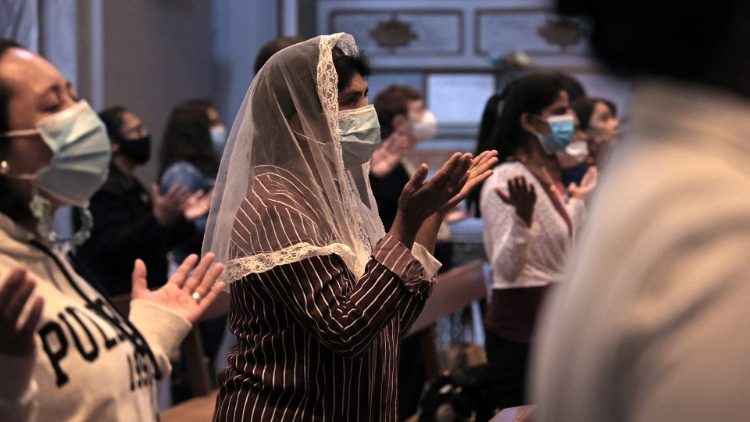
Latin rite Catholics in Cyprus relevant and vital part of social fabric
By Tracey McClure & Christine Seuss
“I am very happy that this visit has been greeted by a lot of excitement not just by the Catholics of the island but by the general population.” Antonella Mantovani, a Latin Catholic Representative in the Cyprus Parliament, tells Vatican News’ Christine Seuss that she is certain that the Mass the ��MAP���� will celebrate at GSP Stadium in Nicosia on Friday will include “a lot of non-Catholics” because “it is such an important event for Cyprus and I’m very glad that it has a very unifying and positive response from everyone on the island and we are grateful to the Cyprus government and to the Orthodox Archbishop for inviting his Holiness to come to Cyprus – and we’re also very happy that he has accepted the invitation.”
Catholics in Cyprus
Though Catholics, including Maronites, Armenians, locals, and temporary residents represent a small community, “we’re probably about 30-40,000 so it’s not a high numerical number but because we’re on the periphery,” Mantovani says, “it’s nice to have that encouragement and support from the Church [so that we realize] we’re not on our own. So, it’s a lovely message for everyone.”
Latin rite Catholics, one of the island’s three prominent Catholic communities, trace the origins of their community in Cyprus back to 1192 with the arrival of Richard the Lionheart, Mantovani recalls, noting that they are currently cataloging an oral history of the Latin families that have made up their community over the centuries. “People are getting older and it would be a shame to miss the opportunity to record the origins of the current community.”
Mapping the Latin community’s oral history is just one of a number of projects that the Church and her office are undertaking to shine the spotlight on Latin-rite Catholics so that the population “are aware that we exist,” Mantovani says. They’ve also embarked on a project with Cyprus’ Institute of Neurology and Genetics for “community tracing of social groups” to determine the ethnic origins of the Latin community in Cyprus - part of a wider program underway with other social groups on the island. Such initiatives aim to strengthen the links between members of the Latin community and to continue to make it “a relevant and vibrant part of the social fabric of Cyprus today.”
Island’s Christian heritage
While the island’s long Christian presence has been interrupted at times, particularly by the Ottoman conquest in 1571 when the Catholic population diminished “dramatically,” Mantovani notes that European Catholics began to return to Cyprus beginning in the 18th century. Through to modern times, Catholics from Europe have arrived on the island for trade, and as shipping agents, doctors and engineers, establishing the Latin community over several hundred years, she recalls.
The Latin community
Indeed, the Latin community’s important contributions to the island’s heritage were in large part the reason why it was recognized as a separate, distinct group in the 1960 Cyprus Constitution which protects religious freedom, Mantovani says.
Her parliamentary office acts as a link between the Latin Catholic community and the government and focuses on civil interests in educational, cultural and religious matters among others. The government, she emphasizes, has increased cooperation between representatives and the State through the office of the Presidential Commissioner, responsible for facilitating relations between religious groups and government ministries. And, it is important to note that the Holy See is setting up an embassy in Cyprus, she points out.
Asked how her office interacts with the Maronite and Armenian Catholic communities. Mantovani observes that each has very different characteristics and interests. As part of the diaspora, she stresses, Armenians have their own language and a very strong sense of their ethnic origin. Maronites also have their own language which is recognized by the Cyprus government. “They also have villages in the Turkish occupied northern area.”
Integration and collaboration
As Latin Catholics, she affirms, “we are very well integrated into urban Cyprus society with a lot of mixed marriages. So, we all have our own agendas. But we collaborate on projects as well.” Here, Mantovani cites a recent series of short films produced by the Cyprus Broadcasting Corporation which focuses on each of the three groups and is linked to common themes such as their history and French and Italian influence on the Cypriot dialect.
Education
One of the Latin Church’s biggest contributions to Cypriot society, she stresses, has been in the field of education. The Terra Santa College, founded by the Franciscan Order of the Holy Land in 1646 in Nicosia, is the oldest educational Institution in Cyprus that is still operating, she points out. In Limassol, St. Mary’s School was founded in 1923 by the Franciscan Sisters of the Sacred Heart; they will soon be celebrating the Institution’s 100th anniversary, Mantovani observes. These schools continue to provide excellence in education from kindergarten through high school. “There were other schools in the past but what’s important to note is that these schools bring to Cyprus a European culture. They were the forerunners of teaching modern European languages in Cyprus, also in the education of girls because some started as girls’ schools. And they promote multiculturalism on the island because they accept students of any nationality and of any religion so they are truly seeds of multiculturalism.” Not only do they help graduates find good jobs and get into the universities of their choice, they also strive to instill strong ethical values in their students, Mantovani stresses.
Thank you for reading our article. You can keep up-to-date by subscribing to our daily newsletter. Just click here









